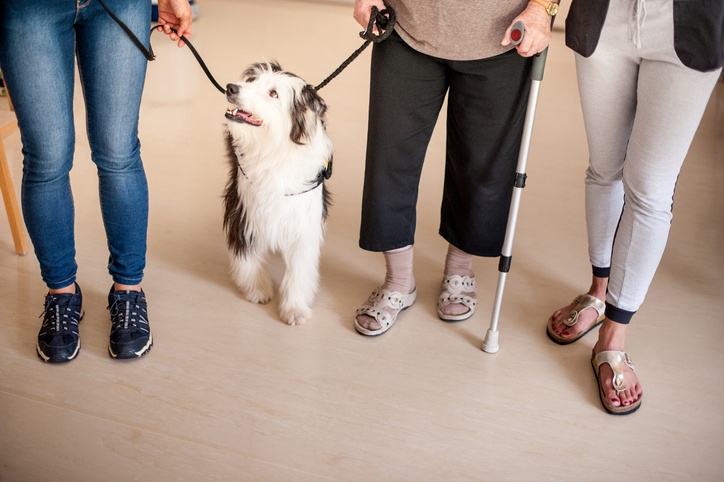
Animal Assisted Therapy Fetches Better Patient Outcomes
Treatment GuidelinesAnimal Assisted Therapy is a growing trend in rehab therapy clinics with research to support it. Therapy dogs can easy anxiety and improve patients' outcomes. Let's look at the history, benefits, safety, and research on therapy dogs in the clinic.
The dog-tor will see you now.
We’ve all seen service dogs in airports and other public spaces for quite some time. Some have even become beloved community members of college campuses and workplaces. But in physical therapy clinics? It’s not that far-fetched.
Animal Assisted Therapy (AAT) is a growing trend in rehab therapy clinics. With evidence-based knowledge growing year after year, clinicians now have more tools than ever to deliver effective patient care.
Evidence supports the use of therapy dogs in physical or occupational therapy clinics. They’re known to ease anxiety and improve patients’ outcomes. In this article, we will look at some possible advantages of introducing dogs to your therapy program by reviewing current literature.
History of Animal Assisted Therapy
Although the formal term for Animal Assisted Therapy is relatively new, its founding principal dates back. The ancient Greeks are said to have cheered up the severely ill with early forms of horse therapy. In the 1800s, Florence Nightingale recognized that small pets reduced anxiety and stress levels for people in psychiatric care.
One of the first scientific studies about the bond between animals in humans was presented in the 1960s by psychologist Dr. Boris Levinson. He stated that humans have an intrinsic need to bond with nature2.
Dr. Levinson first noticed positive outcomes when his dog tagged along to therapy sessions with a very sick child. Sessions with the dog present went much more smoothly than those without.
Then he pursued this idea of therapy with animals. He gathered data from other similar cases. In each of those cases, children were more relaxed, and would communicate more effectively, especially towards the dog3.
At first, the psychology field mocked this hypothesis. Most of his contemporaries thought he was barking up the wrong tree. But eventually, more people came to recognize the potential for dogs to provide therapeutic support.
Research shows less pain, greater satisfaction
Today’s research looks at how Animal Assisted Therapy can benefit inpatient and outpatient facilities. One notable study looked at patients’ perceived pain and satisfaction following total joint replacement when they were exposed to animal therapy for 15 minutes4.
All patients completed same level of physical therapy. Only one group interacted with a therapy dog before treatment. In the end, those with the therapy dog reported their pain at two or more points lower on the Visual Analog Scale (VAS). This group also reported an overall greater level of satisfaction with their hospital stay than the group without the therapy dog4.

Animal Assisted Therapy for veterans
Go in to any Veterans’ Association Medical Center across the country today, and you’ll probably see multiple assistance animals walking around with their veterans. Having a spouse that works in one of these facilities as a clinical psychologist, I regularly hear of the amazing work that these animals do to support the lives of vets both young and old.
In 2018, the US Army Medical Department Journal published a study on therapy dogs. The clinical team and study participants observed that the dogs did much to improve the overall satisfaction and experience with their therapy. They found significant ties from stress levels, fatigue, mood and function to the dogs’ involvement in therapy sessions5.
Pain management with Animal Assisted Therapy
Outpatient pain management clinics have had similar results. When patients interact with a certified therapy dog, their levels of pain, fatigue and emotional distress decrease.
Over a two-month period, one study reported on 295 therapy dog visits. In 23% of visits, pain level decreased by greater than two points on the VAS. These results show that therapy dogs can contribute to a significant reduction in pain and emotional distress for chronic pain patients in an outpatient setting6.
What about the risks?
Introducing animals to a healthcare facility could raise questions about safety. With concerns on both the administrative and patient care side, it is important to look at how other facilities have addressed the issues. After all, many hospitals and schools already allow trained therapy animals because they understand the value they provide.
Remember that therapy dogs and service dogs must be naturally calm and obedient, and properly trained to begin (more on that next).
Still, there’s also the concern of potential pathogens spreading from the animals. Because Animal Assisted Therapy is a relatively new practice, there is not a significant amount of case information available showing the risks of possible illnesses or outbreaks associated with animals in health care facilities.
As a preventive measure, it’s imperative to have strict hand hygiene around animals. For additional information regarding environmental guidelines in a health care facility, visit the CDC8.
Therapy dogs vs service dogs
Therapy dogs are not the same as service dogs. The main difference is where they’re allowed to accompany their owners and their level of training1.
Therapy dogs can accompany their owner everywhere that regular dogs can go. They can sometimes access places that allow therapy animals, such as hospitals and schools.
According to the Alliance of Therapy Dogs, they don’t have to complete special courses or documentation. A well-trained family pet that is obedient, friendly, affectionate, and able to handle clumsy people or those without animal experience, can make a great therapy dog1.
However, the American Kennel Club (AKC) offers official training and certifications for therapy dogs. According to the AKC, the animal should be friendly, calm, obedient and, more importantly, healthy and vaccinated. Also, the animal should not frequently shed, which would increase the risk of allergens spreading in medical facilities7.
On the other hand, service dogs complete specialized training. They learn a specific skill set to help people with physical disabilities, and they are allowed special access in places that may not allow regular pets7.
Is Animal Assisted Therapy right for your clinic?
Aside from the patient benefits, your staff will love having a dog around the clinic! Pet ownership has shown positive effects on heart rate and blood pressure as well as overall happiness9.

Before adding a new program at your clinic, you must first understand if it’s right for your facility and patient population. Usually, the therapy dog belongs to a staff member as a pet, and they bring the dog with them to work. Does anyone at your clinic already own a certified therapy dog? Can you or another staff member adopt and train a therapy dog? Do you have a lot of patients with high anxiety and / or pain?
If you decide you want to bring in therapy dogs or other animals, start by clearly defining how this addition can contribute to your clinic goals. Make a plan to actively involve the animals in patient care, and thoroughly train your staff to work with them. Have a communication plan to inform your patients of this new addition, and have a contingency plan if any patients are afraid of dogs.
Conclusion
Animals have provided people with support and companionship for centuries. Today, that relationship has taken a new development in Animal Assisted Therapy. As a clinical practice, it eases anxiety and increases patients’ overall satisfaction. If Animal Assisted Therapy is a good fit for your clinic, it is sure to delight both patients and staff.
Jeffrey Johnson, MA, ATC
Clinical Specialist
BTE
References
- A history of animal-assisted therapy. Alliance of Therapy Dogs. 2018. https://www.therapydogs.com/animal-therapy/
- Brady, L.J. Animal assisted therapy – A brief history. Professional Development Resources. 2017. https://www.pdresources.org/blog_data/animal-assisted-therapy-a-brief-history/
- Coren, S. How therapy dogs almost never came to exist. Psychology today. 2013. https://www.psychologytoday.com/us/blog/canine-corner/201302/how-therapy-dogs-almost-never-came-exist
- Harper CM, et al. Can therapy dogs improve pain and satisfaction after total joint arthroplasty? A randomized controlled trial. Clinical Orthopedics and Related Research. 2015;473:372.
- Beck CE, Gonzales F Jr, Sells CH, Jones C, Reer T, Zhu YY. The effects of animal-assisted therapy on wounded warriors in an occupational therapy life skills program. US Army Med Dep J. 2012;Apr-Jun:38–45.
- Marcus DA, Bernstein CD, Constantin JM, Kunkel FA, Breuer P, Hanlon RB. Animal-assisted therapy at an outpatient pain management clinic. Pain Med. 2012;13:45–57. doi: 10.1111/j.1526-4637.2011.01294.
- AKC Therapy Dog Program. American Kennel Club. https://www.akc.org/products-services/training-programs/akc-therapy-dog-program/
- Guidelines for environmental infection control in health-care facilities. US Department of Health and Human Services. Centers for Disease Control and Prevention. 2003.
- Glenn, L.N. et al. Pet ownership and cardiovascular risk. American Heart Association Journal. 2013. www.ahajournals.org/doi/full/10.1161/CIR.0b013e31829201e1





